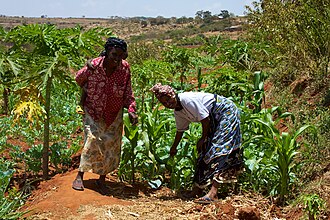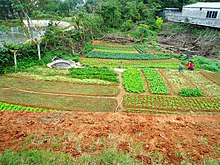Our website is made possible by displaying online advertisements to our visitors.
Please consider supporting us by disabling your ad blocker.
Smallholding


| Rural area |
|---|
A smallholding or smallholder is a small farm operating under a small-scale agriculture model.[2] Definitions vary widely for what constitutes a smallholder or small-scale farm, including factors such as size, food production technique or technology, involvement of family in labor and economic impact.[3] There are an estimated 500 million smallholder farms in developing countries of the world alone, supporting almost two billion people.[4][5] Smallholdings are usually farms supporting a single family with a mixture of cash crops and subsistence farming. As a country becomes more affluent, smallholdings may not be self-sufficient. Still, they may be valued for providing supplemental sustenance, recreation, and general rural lifestyle appreciation (often as hobby farms). As the sustainable food and local food movements grow in affluent countries, some of these smallholdings are gaining increased economic viability in the developed world as well.
Small-scale agriculture is often in tension with industrial agriculture, which finds efficiencies by increasing outputs, monoculture, consolidating land under big agricultural operations, and economies of scale. Certain labor-intensive cash crops, such as cocoa production in Ghana or Côte d'Ivoire, rely heavily on smallholders; globally, as of 2008, 90% of cocoa is grown by smallholders.[6] These farmers rely on cocoa for up to 60 to 90 per cent of their income.[7] Similar trends in supply chains exist in other crops like coffee, palm oil, and bananas.[8] In other markets, small scale agriculture can increase food system investment in small holders improving food security. Today, some companies try to include smallholdings into their value chain, providing seed, feed, or fertilizer to improve production.[9]
Because smallholding farms frequently require less industrial inputs and can be an important way to improve food security and sustainable food systems in less-developed contexts, addressing the productivity and financial sustainability of smallholders is an international development priority and measured by indicator 2.3 of Sustainable Development Goal 2.[10][3] Additionally, since agriculture has such large impacts on climate change, Project Drawdown described "Sustainable Intensification for Smallholders" an important method for climate change mitigation.[11]
- ^ Gulden, Kathrine Torday (Mar 8, 2019). "International Women's Day: Closing the gender gap among smallholders". Nibio EN. Retrieved 2021-10-05.
- ^ Babu, Suresh C.; Sanyal, Prabuddha (2009). "Effects of commercialization of agriculture (Shift from traditional crop to cash crop) on food consumption and nutrition – application of chi-square statistic". Food Security, Poverty and Nutrition Policy Analysis. pp. 39–59. doi:10.1016/B978-0-12-374712-9.00003-1. ISBN 978-0-12-374712-9.
- ^ a b Khalil, Clara Aida; Conforti, Piero; Ergin, Ipek; Gennari, Pietro (June 2017). "Defining Small-scale Food Producers to Monitor Target 2.3. of the 2030 Agenda for Sustainable Development" (PDF) (Report). FAO Statistics Division. Archived (PDF) from the original on Nov 8, 2020.
- ^ "Food prices: smallholder farmers can be part of the solution". IFAD. Archived from the original on 2013-05-05. Retrieved 2018-01-02.
- ^ "Investing in smallholder agriculture for food security" (PDF). Food and Agriculture Organization of the United Nations. High Level Panel of Experts on Food Security and Nutrition. June 2013. Retrieved 23 February 2021.
- ^ "How many smallholders are there worldwide producing cocoa? What proportion of cocoa worldwide is produced by smallholders?". International Cocoa Organization. 27 March 2012. Archived from the original on Oct 20, 2020. Retrieved 2020-10-17.
- ^ "Why Sustainable Cocoa Farming Matters for Rural Development". www.csis.org. 6 September 2012. Retrieved 2020-11-30.
- ^ Schneider, Kate; Gugerty, Mary Kay (August 17, 2010). Impact of Export-Driven Cash Crops on Smallholder Households (Report). Evans School Policy Analysis and Research.
- ^ Christina Gradl; et al. (March 2013). "Promising agribusiness". dandc.eu.
- ^ "2.3.1 Productivity of small-scale food producers | Sustainable Development Goals | Food and Agriculture Organization of the United Nations". www.fao.org. Retrieved 2020-10-17.
- ^ "Sustainable Intensification for Smallholders". Project Drawdown. 2020-02-06. Retrieved 2020-10-16.
Previous Page Next Page


